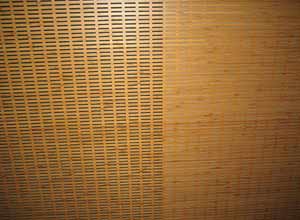Perforated Metal and Wood Ceilings: Sustainability, Acoustics, and Aesthetics
Noise Reduction: The traditional approach to reducing noise with perforated panels is to use them as a covering over sound-absorbing materials such as glass or cotton fiber batts. Perforations allow noise to pass through the panels and into the acoustical insulation while providing a durable and attractive finish system. When sound contacts the fibers in the acoustical insulation, the fibers vibrate and convert mechanical energy into friction and minute quantities of heat. Glass fiber insulation batts with a density of three pounds per cubic foot can deliver NRC .95 in a one-inch thick installation, and an outstanding NRC > 1.00 (equal to absorbing all sound impinging on the ceiling) is even possible when two inches are used. Recycled cotton batts have similar performance.
|
It is not always practical to use batts, however. Installing batts on the backside of a panel, for example, raises concerns about the appearance of a perforated panel. The weight of the batt factors into installation labor. The potential for condensation within the insulation rules them out in moist environments. And the possibility that fibers will slough off the batts makes them unacceptable in certain occupancies.
Fortunately, a new type of non-woven acoustical fabric provides a welcome alternative for use in most perforated ceilings. These paper-thin fabrics, only 0.2 mm thick, can produce an impressive NRC .75 when used with selected perforated panels-performance equal to many conventional acoustical ceiling tiles. The engineered fabrics reduce noise by creating resistance to the air flow caused by the oscillating air pressure of a sound wave. To be effective, perforated panels with acoustical fabric should be installed with at least 16 inches of airspace behind them. This is because air is an elastic medium; if the air cavity behind the panels was shallower, the air would be too "stiff" and would interfere with the air pressure oscillations.
The fabric is available in colors to create visual options: light-colored fabrics can also be backlit to create luminous ceilings. They are self-extinguishing when exposed to flame and are compatible with the Class A flame spread ratings of metal and wood/metal hybrid panel systems.










